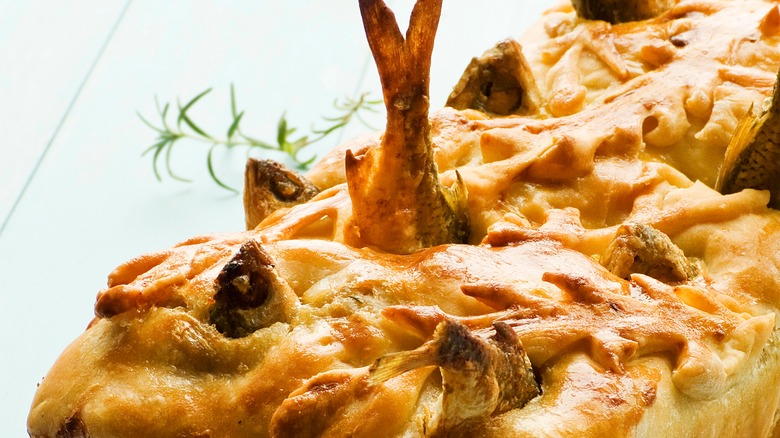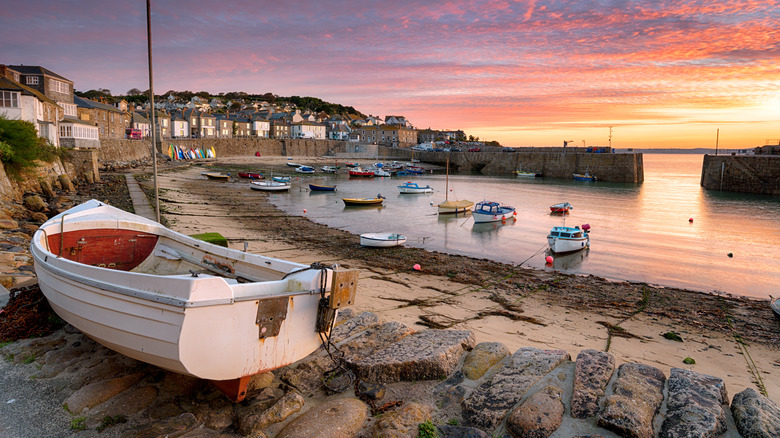Britain's Rare Fish Head Pie Has Heroic Origins
Fish head pie can be sampled throughout Britain, but only one town can rightfully claim to be the originator. Mousehole, a quaint Cornwall fishing village, holds that distinction.
The fish head pie, also known by several other names, traditionally contains seven different types of white fish. They represent the species snared by Tom Bawcock, the central figure in the fish head story. According to Oddity Central, they are sand eels, horse mackerel, pilchards, herring, dogfish, and ling, with an unknown seventh variety. Haddock, hake, cod, and coley are other candidates, depending on the season. Sardine heads, and sometimes tails, are also essential components of the fish head pie. The heads protrude from the crust, gazing sightlessly upward. Placing the fish accordingly also permits the oil to drain into the pie, enhancing the flavor. The pie's interior may contain herbs, lemon zest, grated eggs, mashed potatoes, or cream, and a savory roux. A pastry topper completes the dish.
Foods of England cites what may be the earliest known reference to fish head pies. "The Journals of Captain Frederick Hoffman" describes a pie made of fish with their heads visible above the crust. Lucy Worsley depicts food connoisseur Dorothy Hartley's rendition: individual, pastry-wrapped fish looking like stout pigs in blankets. Mousehole (pronounced "Mowzel") is steeped in history, and the origin of its signature fish head pie is literally the stuff of legends.
Saved by a brave fisherman
Tom Bawcock, a 16th-century Mousehole fisherman, is credited with saving the village from starvation. The fish head pie memorializes his act of bravery, and the town still holds an annual festival in his honor. As described in Cornwall Live, Mousehole was nearing starvation, battered by a storm that trapped its fishing fleet in the harbor. Only Bawcock braved the waves. He eventually returned loaded with fish, enough, according to legend, to feed the entire village in an enormous pie. It contained all the local species, and fish heads were situated outside the crust, staring at the stars with gratitude. The village commemorates his deed with a festival every December 23. Paper boats are launched into the harbor, illuminated by lanterns and lights. The piece de résistance, fish head pies, are served free at the centuries-old Ship Inn.
In a variation of the legend, Tom Bawcock was accompanied by his cat, whose calming presence helped quell the storm. "The Mousehole Cat," a children's book by Antonia Barber, depicts this telling of the tale. Two other versions of the fish head pie's origins minimize the contribution of Bawcock. Per Matador Network, it might simply be a matter of local fishermen giving thanks each Christmas for the sea's bounty by baking a giant pilchard pie. A second explanation has locals throwing everything but the kitchen sink into a giant pie to frighten the Devil into thinking he would share the same fate.
More Mousehole history and heroism
As recounted by Social Shorthand, four days before Bawcock's December 23, 1981 holiday, a Mousehole lifeboat was dispatched to rescue the crew and passengers of the foundering Union Star. Despite 60-foot swells and gale-force winds, the rescuers persisted, only to be lost along with everyone on the other ship. Every year during the Bawcock festivities, the lights are turned off for an hour to honor the heroes. One of the victims was the landlord of the fishhead pie-baking Ship Inn.
In addition to Bawcock, another hero figures in Mousehole's history. The Spanish Armada attempted to burn the village in 1595. All residents, save one, fled, and he remained behind to resist and was killed. However, his house was the only one to survive the inferno, making it the oldest standing structure in Mousehole. Cornwall Online cites another local celebrity: Dolly Pentreath. She is considered the last remaining person who spoke exclusively in the Cornish language.
Tom Bawcock is still revered as the savior of Mousehole and the inspiration for the iconic fish head pie. He and his culinary contribution are still celebrated every year in Cornwall village.


